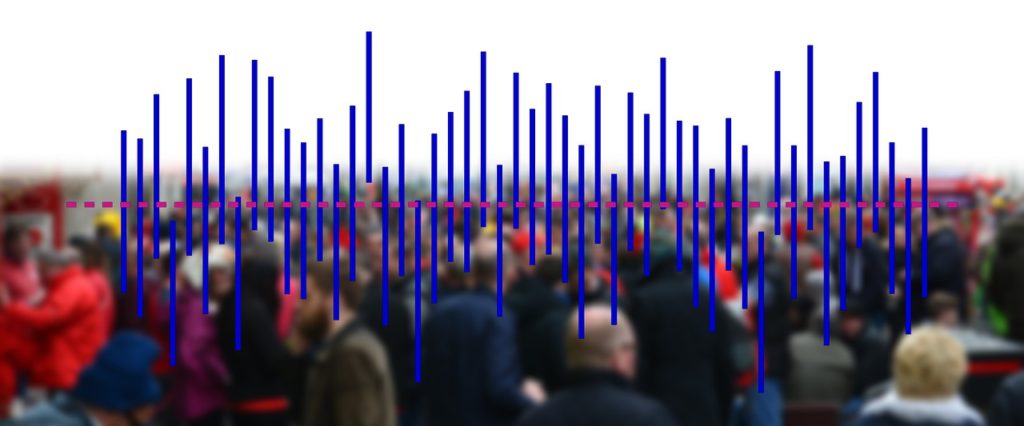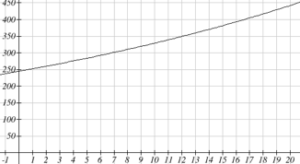Solve Exponentials for Time: Logarithms
Learning Outcomes
- Evaluate and rewrite logarithms using the properties of logarithms
- Use the properties of logarithms to solve exponential models for time
- Identify the carrying capacity in a logistic growth model
- Use a logistic growth model to predict growth
Reversing an Exponent
Earlier, we found that since Olympia, WA had a population of 245 thousand in 2008 and had been growing at 3% per year, the population could be modeled by the equationPn = (1+0.03)n (245,000), or equivalently, Pn = 245,000(1.03)n.
Using this equation, we were able to predict the population in the future. Suppose we wanted to know when the population of Olympia would reach 400 thousand. Since we are looking for the year n when the population will be 400 thousand, we would need to solve the equation
Suppose we wanted to know when the population of Olympia would reach 400 thousand. Since we are looking for the year n when the population will be 400 thousand, we would need to solve the equation
400,000 = 245,000(1.03)n
Dividing both sides by 245,000 gives
1.6327 = 1.03n
One approach to this problem would be to create a table of values, or to use technology to draw a graph to estimate the solution. From the graph, we can estimate that the solution will be around 16 to 17 years after 2008 (2024 to 2025). This is pretty good, but we’d really like to have an algebraic tool to answer this question. To do that, we need to introduce a new function that will undo exponentials, similar to how a square root undoes a square. For exponentials, the function we need is called a logarithm. It is the inverse of the exponential, meaning it undoes the exponential. While there is a whole family of logarithms with different bases, we will focus on the common log, which is based on the exponential 10x.
From the graph, we can estimate that the solution will be around 16 to 17 years after 2008 (2024 to 2025). This is pretty good, but we’d really like to have an algebraic tool to answer this question. To do that, we need to introduce a new function that will undo exponentials, similar to how a square root undoes a square. For exponentials, the function we need is called a logarithm. It is the inverse of the exponential, meaning it undoes the exponential. While there is a whole family of logarithms with different bases, we will focus on the common log, which is based on the exponential 10x.
Common Logarithm
Example
- log(100)
- log(1000)
- log(10000)
- log(1/100)
- log(1)
Answer:
- log(100) can be written as log(102). Since the log undoes the exponential, log(102) = 2
- log(1000) = log(103) = 3
- log(10000) = log(104) = 4
- Recall that [latex]{{x}^{-n}}=\frac{1}{{{x}^{n}}}[/latex]. [latex]\log\left(\frac{1}{100}\right)=\log\left({{10}^{-2}}\right)=-2[/latex]
- Recall that x0 = 1. log(1) = log(100) = 0
Solving exponential equations with logarithms
- Isolate the exponential. In other words, get it by itself on one side of the equation. This usually involves dividing by a number multiplying it.
- Take the log of both sides of the equation.
- Use the exponent property of logs to rewrite the exponential with the variable exponent multiplying the logarithm.
- Divide as needed to solve for the variable.
Example
If Olympia is growing according to the equation, Pn = 245(1.03)n, where n is years after 2008, and the population is measured in thousands. Find when the population will be 400 thousand.Answer: We need to solve the equation
400 = 245(1.03)n Begin by dividing both sides by 245 to isolate the exponential
1.633 = 1.03n Now take the log of both sides
log(1.633) = log(1.03n) Use the exponent property of logs on the right side
log(1.633)= n log(1.03) Now we can divide by log(1.03)
[latex]\frac{\log(1.633)}{\log(1.03)}=n[/latex] We can approximate this value on a calculator
n ≈ 16.591
A full walkthrough of this problem is available here. https://youtu.be/liNffAACIUsExample
Polluted water is passed through a series of filters. Each filter removes 90% of the remaining impurities from the water. If you have 10 million particles of pollutant per gallon originally, how many filters would the water need to be passed through to reduce the pollutant to 500 particles per gallon?Answer: In this problem, our “population” is the number of particles of pollutant per gallon. The initial pollutant is 10 million particles per gallon, so P0 = 10,000,000. Instead of changing with time, the pollutant changes with the number of filters, so n will represent the number of filters the water passes through. Also, since the amount of pollutant is decreasing with each filter instead of increasing, our “growth” rate will be negative, indicating that the population is decreasing instead of increasing, so r = -0.90. We can then write the explicit equation for the pollutant:
Pn = 10,000,000(1 – 0.90)n = 10,000,000(0.10)n
To solve the question of how many filters are needed to lower the pollutant to 500 particles per gallon, we can set Pn equal to 500, and solve for n.500 = 10,000,000(0.10)n Divide both sides by 10,000,000
0.00005 = 0.10n Take the log of both sides
log(0.00005) = log(0.10n) Use the exponent property of logs on the right side
log(0.00005) = n log(0.10) Evaluate the logarithms to a decimal approximation
-4.301 = n (-1) Divide by -1, the value multiplying n
4.301 = n
It would take about 4.301 filters. Of course, since we probably can’t install 0.3 filters, we would need to use 5 filters to bring the pollutant below the desired level. More details about solving this scenario are available in this video. https://youtu.be/sLLu0u1YgM0Try It
India had a population in 2008 of about 1.14 billion people. The population is growing by about 1.34% each year. If this trend continues, when will India’s population reach 1.2 billion?TIP
When you are solving growth problems, use the language in the question to determine whether you are solving for time, future value, present value or growth rate. Questions that uses words like "when", "what year", or "how long" are asking you to solve for time and you will need to use logarithms to solve them because the time variable in growth problems is in the exponent.Licenses & Attributions
CC licensed content, Original
- Revision and Adaptation. Provided by: Lumen Learning License: CC BY: Attribution.
CC licensed content, Shared previously
- Solve Exponentials for Time: Logarithms. Authored by: David Lippman. Located at: http://www.opentextbookstore.com/mathinsociety/. License: CC BY-SA: Attribution-ShareAlike.
- population-statistics-human. Authored by: geralt. License: CC BY: Attribution.
- Using logs to solve for time. Authored by: OCLPhase2's channel. License: CC BY: Attribution.
- Using logs to solve an exponential. Authored by: OCLPhase2's channel. License: CC BY: Attribution.
- Question ID 100163. Authored by: Rieman,Rick. License: CC BY: Attribution.
- Question ID 1764. Authored by: Lippman,David. License: CC BY: Attribution. License terms: IMathAS Community License CC-BY + GPL.
- Question ID 34625. Authored by: Smart,Jim. License: CC BY: Attribution. License terms: IMathAS Community License CC-BY + GPL.
